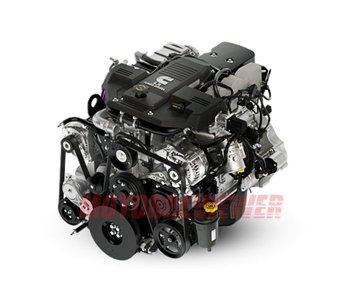Cummins ISB 6.7L Engine Specs, Problems, Reliability, Info

Cummins ISB 6.7-liter straight-six turbodiesel engine is the latest and biggest version of the B series. The ISB 6.7 is also the most powerful diesel engine produced by Cummins (350 hp and 650 lb-ft of torque) for light/medium-duty trucks.
Its predecessor, the ISB 5.9, has been produced almost ten years. At that moment, it was outdated and depleted the limits of possibilities for improvements in terms of fuel consumption and emissions. The market wanted a new engine for medium-duty trucks and buses, and the ISB 6.7 engine became the answer for that. The 6.7 ISB had an increased cylinder bore (4.21 inches or 106.9 mm) and piston stroke (4.88 inches or 124.0 mm). That increased its displacement to 6.7 liters (408 cubic inches). The engine block is still made from cast iron. On top of the block, there is a 24-valve cast iron cylinder head similar to the ISB 5.9. The difference between ISB 5.9 and 6.7 cylinder head is the ISB6.7 head has holes (Sensor Hole Style head) from the air intake plenum side. There are many changes compared to the last generation B5.9 version, but the overall design remains the same. The 6.7L Cummins engine had a high-pressure Common Rail fuel injection system, electronically controlled fuel injection pump, and new equipment for emissions reduction.
The new version was designed guided by stricter requirements on Federal emissions regulations. In 2007, the first year in production, the engine was the first Cummins diesel equipped with a diesel particulate filter (DPF). The DPF filter cleans the exhaust gases from soot by more than 90 percent. A diesel particulate filter has a ceramic matrix, which filters soot particles and regenerates them under high temperature, heated by exhaust gases. Also, the engine had the exhaust gas recirculation system (EGR) with cooling. In the 2010 model year, the engine received an additional DEF (diesel exhaust fluid), SCR (selective catalytic reduction), and EGR cooler. The DEF fluid is injected inside the DPF to help the regeneration process of soot at the lower temperature. So 2 liters of DEF is consumed for every 100 liters of diesel fuel.
Holset HE351VE variable geometry turbocharger (VGT) is another interesting new feature of the engine. This turbocharger can block exhaust flow to increase temperatures inside the DPF, which reduces emission levels. The VGT also has an integrated exhaust brake function. It does the engine braking by restricting exhaust flow. All ISB6.7 engines are equipped with an air-to-air intercooler.
The improvement process has never been stopped during the last ten years of production, so the 2017 model year engines already produce up to 900 lb-ft of torque. The ISB6.7 also was laid into the basis of the smaller version - ISB4.5 (a 4.5-liter straight four-cylinder turbodiesel engine).
Engine Specs
Oil recommendations and capacity may vary depending on the car model, year, and market. Please check the service manual specific to your vehicle!
ISB6.7 Reliability, Problems, and Failure
The 6.7 ISB has become the most reliable Cummins B engine to date. In stock form, the failure rates are meager. The common problems are related to emissions equipment and Common Rail Fuel injection. The EGR system is prone to clogging, and that issue is typical to all engines equipped with EGR. The DPF longevity is about 100,000 miles. Some owners prefer to install DPF aftermarket delete kits, which undoubtedly cheaper but less friendly to nature. Also, keep in mind, long idle times are not tolerant for the VGT. ISB6.7 fuel injectors also demand attention at 200k mileage. Owners report that 6.7 injectors are more reliable than injectors used in the 5.9 version.
Modifications
Dodge ISB 6.7 Truck's Transmissions and Power:
In 2007 the 6.7 liters engine was introduced in 350 hp and 650 lb-ft version with Chrysler-built six-speed 68RFE automatic transmission, and 350 hp and 610 lb-ft modification attached to the Mercedes G56 6-speed manual transmission. The 2007 and newer 3500 trucks had only 305 hp and have being equipped with the Aisin AS68RC or the Mercedes G56 6-speed manual transmission. The 2008 4500/5500 medium duty trucks received the 350 hp and 610 lb-ft version of the engine, which come with the Aisin AS68RC or the Mercedes G56 manual. Since 2011, the 68RFE automatic transmission offered with 350-370hp and 800 lb-ft version of 6.7 liter engine. Since 2013, the Aisin AS69RC transmission became available for 3500 only with B6.7 engine produced 385 hp and 850-900 lb-ft of torque.
